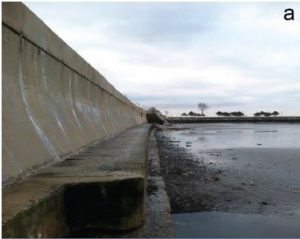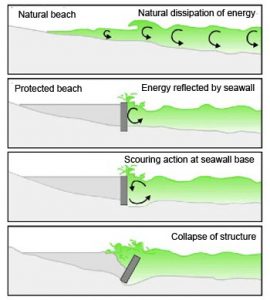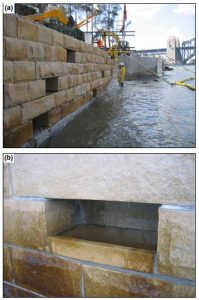Seawalls: Allowing humans to build closer to water, but altering processes along shorelines.
By Abby Tinari, SRC intern
Participating in the Shark Research and Conservation Program’s Urban Shark Project, I have spent a decent amount of time on the water throughout downtown Miami. In this time, I have noticed the concrete shoreline that shapes Miami’s shores. Of course, there are sandy beaches, but much of the barrier between land and water is a hardened seawall. It made sense, considering 20 feet from the seawall is a high-rise building, that needs the support and the seawall provides. This realization, at how much humans have changed and destroyed the coastlines, intrigued me. I then started to wonder how has shoreline hardening and urbanization effected the marine environment?
Coastal cities around the world are hardening their coasts. As the desire to be along the water increases there is a higher pressure to create structures that support buildings. These hard structures replace the natural shoreline, creating a barrier between land and water. Depending on the area and the infrastructural need, a variety of structures can be used. An alternative to natural shorelines, including seawalls, are used to provide stability for sediment and infrastructure built upon the sediment through erosion prevention (Gittman, Scyphers, Smith, Neylan, & Grabowski, 2016). Seawalls are also used as protection from wave energy and storm surges. Seawalls allow humans to complete their desire of living along the coast when they otherwise would have to move inland when the land erodes away. If designed properly, they can be used to prevent sea level rise in a low lying area. The vertical nature of seawalls occupy considerably less space than other shoreline armoring structures, making it an ideal structure in cities and areas where space is limited. Seawalls can last over 30 years in saline environments if designed and maintained properly.

Example of engineered-shore structures: seawall (Gittman et al., 2016)
Although seawalls are important coastal structures they produce adverse effects on the coastal environment. Removing the natural shoreline disturbs and changes longshore currents, wreaking havoc on properties and the shoreline farther along the current. Seawalls remove areas where erosion and deposition would otherwise take place. The sediment in water is deposited somewhere else, altering sediment transport and causing sediment starvation. Sediment starvation usually occurs at the end of a seawall where water velocity speeds up, eroding sediment. Because there is a lack of sediment transferred along the wall the sediment eroded at the end does not have anything to replace it, creating a “starved” area. Erosion still occurs around seawalls, just not along the shoreline. It is prevalent at the base in front of the wall and can weaken the structure due to the change in forces acting on the wall (Figure 2). Concrete does not absorb and reflect energy as a beach or rocky shoreline would. Much of the wave energy is reflected, creating potential boating hazards. These are just the physical process seawalls change.

Erosion occurring at the base of the seawall. Scour erodes sediment that leads to an unstable structure and possible collapse. (ctmirror.org)
How are seawalls affecting organisms that were once present in urban environments? Are they changing biodiversity? One obvious effect seawalls have is they remove natural habitat, reducing the amount of shoreline conducive for organisms. Plants and animals are unable to travel between terrestrial and marine environments reducing the connectivity between the two communities. In the past, as sea level rises, ecosystems have been able to adjust, slowly moving inland. With a concrete barrier, inland migration is extremely difficult, if not impossible for plants and animals. This could lead to a loss of nursery and foraging grounds for birds and fish (Bulleri & Chapman, 2010). These vertical structures reduce the size of the intertidal zone, crowding intertidal species into smaller areas. This zone is the bridge for energy exchange between marine and terrestrial environments (Sobocinski, Cordell, & Simenstad, 2010). Abundances and assemblages of organisms are changing due to the difference in substrate. The lack of crevices and protection from predators and wave energy reduce the likelihood of larval survival (Bulleri & Chapman, 2010). Many of the species sea walls directly affect are sessile, meaning they are immobile. If larvae are not able to survive on the seawall then adults will not be able to either. The lack of native organisms has the potential for exotic species to flourish. In certain situations seawalls do benefit the marine community. Seawalls in Sydney Harbor, Australia provide shading, which has led to an increase in species diversity (Bulleri & Chapman, 2010). Bulleri and Gittman through literature searches found that seawalls do significantly decrease the biodiversity of abundance of species when compared to natural shorelines.
Seawalls are essential to coastal urban infrastructure, but how can we reduce the impact they have on the ecosystem while still having the same structural benefit? In areas where space is available living seawalls can be an excellent alternative. Living seawalls are typically layered or terraced. Each layer provides habitat for different organisms. These work bridge the connectivity gap between terrestrial and marine environments. Fake mangrove panels are a new alternative for South Florida’s sea walls. The panels are concrete but mimic red mangroves, an important habitat for many of South Florida’s marine organisms. University of Kansas assistant professor, Keith Van de Reit, designed these panels which, so far, are proving to be successful in creating habitat for organisms. Riprap, while not providing the same strength as a sea wall can increase the biological activity of the structure. If the stability cannot be compromised, walls such as one in Sydney Harbor (Figure 3), can be useful to mimic a rocky tidal pool environment. The openings in the walls are placed so they are flooded at high tides but retain water at low tides. This provides an environment for rocky tidal species, a marine environment common in Sydney.

(a) Intertidal ‘rock-pools’ constructed in the vertical dace of a seawall in Sydney Harbor (Australia). These features of habitat were introduced to seawalls to mitigate efforts of loss or degradation of rocky platforms on intertidal biodiversity. (b) Details of a rock-pool retaining water during low tide. (Bulleri & Chapman, 2010)
Although there are some studies on the biological impact of seawalls, more research needs to be done, especially with the rising coastal population. Other alternatives, like the mangrove panels, should be researched. A healthier and more ecologically connected water way helps human in numerous ways. It would increase water quality and create habitat. It would also provide for more tourism and an economic benefit for cities.
Works Cited
Bulleri, F., & Chapman, M. G. (2010). The introduction of coastal infrastructure as a driver of change in marine environments. Journal of Applied Ecology, 47(1), 26-35. doi:10.1111/j.1365-2664.2009.01751.x
Gittman, R. K., Scyphers, S. B., Smith, C. S., Neylan, I. P., & Grabowski, J. H. (2016). Ecological Consequences of Shoreline Hardening: A Meta-Analysis. Bioscience, 66(9), 763-773. doi:10.1093/biosci/biw091
Sobocinski, K. L., Cordell, J. R., & Simenstad, C. A. (2010). Effects of Shoreline Modifications on Supratidal Macroinvertebrate Fauna on Puget Sound, Washington Beaches. Estuaries and Coasts, 33(3), 699-711. doi:10.1007/s12237-009-9262-9
Spiegel, Jan Ellen. “Connecticut’s Trouble with Seawalls.” The CT Mirror. N.p., 17 Feb. 2014. Web. 24 Mar. 2017
